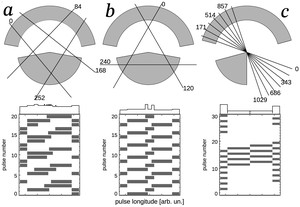
Radio pulsars exhibit a large diversity of pulsation styles. The radio flux is modulated on timescales longer than the star spin period, and sometimes the flux drops below detection level (nulling). After hundreds of pulses, a single pulsar can go from one pulsation mode to another.
An example of a notorious modulation pattern is the one observed for the first known radio pulsar PSR B1919+21 (Arecibo Observatory data from Proszynski & Wolszczan 1986). As can be seen near pulse longitude -27, the phase of
pulse modulation can change abruptly within the pulse window for unknown reason. In another enigmatic pulsar (B1237+25, Hankins & Wright 1980) the radio emission first appears on the left side, then on the right side and finally in the central part of the profile, and the sequence is repeated. In another pulsation mode of the same pulsar, the radio emission ceases in the inner parts of the profile, ie. the pulsar switches between core-bright and conal-bright pulsation modes (Srostlik & Rankin 2005). The different modes tend to be separated by nulls.
All the above described modulations can be roughly reproduced by a structured radio emission beam with antisymmetric distribution of radio-bright zones, as shown in grey on top part of the figure. The beam is slowly rotating around its middle point because of an ExB plasma drift, ie. a sideway drift of plasma in the presence of nonparallel electric and magnetic fields. Therefore, our sightline is passing at always-different azimuths within the beam. The sightline paths are marked with straight line sections on the grey beam pictures (the numbers give increasing azimuths). Depending on the ratio between the star spin and the beam drift, different pulsation styles are generated as shown in the figure's bottom.
The proposed beam geometry is different from the traditional "carousel of sparks". Instead, the beam bears considerable resemblance to the known structure of pulsar magnetosphere, as defined by the last-open and critical magnetic field lines, as well as the acceleration-favorable and unfavorable field regions. However, since the latter regions do not seem to take part in the drift motion, the physical origin of the antisymmetric beam remains unclear. The problem was investigated by Jarosław Dyks for the Copernicus Astronomical Center in Dyks (2022).
Dyks, J., 2022, Proc. IAU Symposium 363, ed. E. Troja & M. Baring,
astro-ph//2203.05572
Hankins, T.H., & Wright, G.A.E., 1980, Nature, 288, 681
Proszynski, M. & Wolszczan, A., 1986, ApJ, 307, 540
Srostlik, Z., & Rankin, J.M., 2005, MNRAS, 362, 1121






